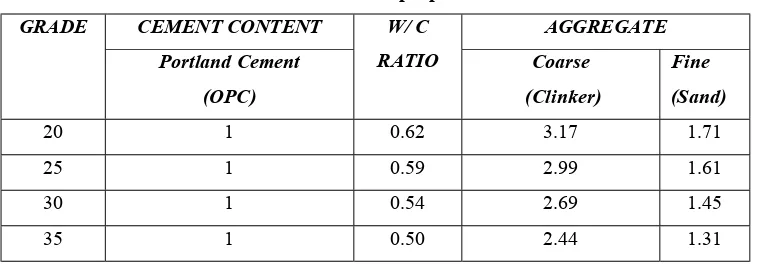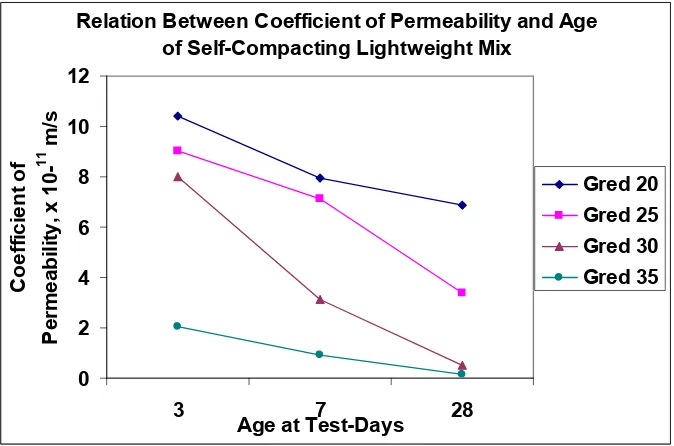International Conference On Concrete Engineering and Technology (2004) Universiti Malaya
WATER PERMEABILITY OF LIGHTWEIGHT AGGREGATE
CONCRETE
1
Suhaizad Sulaiman,
2Y.L.Lee,
3HB Koh,
4Ting Leong Wu
1KUiTTHO, Parit Raja, 86400 Batu Pahat, Johor.2Deputy Director (R&D), KUiTTHO 3Head of Computer Laboratory, KUiTTHO
4Researcher, KUiTTHO
ABSTRACT.This paper reports the study of water permeability of self-compacting lightweight aggregate concrete. In this study, palm clinker (POC) is used to replace normal weight aggregates to produce lightweight concrete. There are two types of mix design in this project. The POC mix as the control mix and POC mix with 10 % Micronised Silica (TIA 60) as the cement replacement material and superplasticizers (Rheobuild 1100) to produce the self-compacting lightweight concrete. The test cubes are 100 mm x 100 mm x 100 mm size and wet-cured. Slump test and compacting factor test are carried out to measure the workability of the concrete. Durability of the concrete is determined by the water permeability test based on ISO/DIS 7031, while the compressive strength of the hardened concrete is measured based on BS 1881: Part 2. Water permeability test and compressive strength test are conducted on the cubes of these two types of concrete mix at the age of 3 , 7 and 28 days. This self-compacting lightweight concrete is exhibiting unique properties as low water / cement ratio below 0.5 exhibits high workability up to 150 mm of slump. The self-compacting concrete requires minimal vibration to achieve high strength. The average coefficient of water permeability is in the order of 10-11 m/s, which can be classified as an average quality concrete. The reduction of density is approximately 11.2% compared with the OPC normal weight concrete. This concrete mix is expected to be useful for the development of friction piles towards achieving technical, environmental and economical advantages for the construction of soft soil foundation.
INTRODUCTION
Self-compacting concrete has various advantages for the construction industry with its flowing characteristics and capable of filling up all the voids in heavily reinforced section. It reduces the casting time and effort with less vibration for effective compaction [1-10]. Aggregate gradation is one of the components for creating self-compacting concrete. It is necessary, in most cases, to use a coarse aggregate and sand in the correct ratio to adequately fill any voids for optimal concrete matrix and enhanced workability. The resulting effect is better working environment with less noise and more durable concrete with high performance characteristic [11-24].
Lightweight concrete may be defined as the concrete of substantially lower unit weight than that made from gravel or crushed stone. The lightweight concrete is prepared by using light aggregates or formation of air voids in concrete by omitting sand or formation of air void in cement paste by the addition of substances which produce foam.
EXPERIMENTAL WORK
Mix Design
Table 1: The mix proportion for POC concrete
CEMENT CONTENT AGGREGATE GRADE
Portland Cement (OPC)
W/ C
RATIO Coarse (Clinker)
Fine (Sand)
20 1 0.62 3.17 1.71
25 1 0.59 2.99 1.61
30 1 0.54 2.69 1.45
35 1 0.50 2.44 1.31
Table 2: The mix proportion for self-compacting lightweight concrete
CEMENT CONTENT AGGREGATE GRADE
Portland Cement
TIA 60
W/ C
RATIO Coarse (Clinker)
Fine (Sand)
SUPER-PLASTICIZER (Rheobuild 1100)
ml/kg cement
20 0.9 0.1 0.48 2.83 2.05 1.2
25 0.9 0.1 0.47 2.67 1.94 1.2
30 0.9 0.1 0.43 2.40 1.74 1.2
35 0.9 0.1 0.40 2.18 1.58 1.2
Procedure of Batching the Materials
After the trial mix process, the fresh concrete was cast in 100 mm x 100 mm x 100 mm steel mould. The moulds have to be greased before placing the concrete. This is to ensure that the concrete cube can be taken out from the mould easily. The hand rodding and mechanical vibrations methods are commonly applied in the compaction of concrete. The mechanical vibration used in this project is the vibrating table.
The mould can be opened one day after placing the concrete into the mould and the concrete cubes are placed in the curing tank at a temperature of around 27 °C. The concrete cubes were subjected to water permeability and compressive strength test at 3, 7 and 28 days.
Types of Testing
The analysis of the data obtained from the laboratory works is presented. The analysis is done to determine the proportion of palm clinker concrete with micronised silica (TIA 60) to replace 10% of the total cement required and superplasticizers (Rheobuild 1100) to produce self-compacting lightweight concrete with maximum compressive strength and minimum water permeability as compared to the control mix. The workability for the concrete is also determined.
The following tests are also conducted in this project: i. Sieve analysis for the fine and palm clinker.
ii. Slump test. The slump test is based on BS 1881: Part 102: 1983. iii. Compressive strength test using the ELE Compact 1500 Machine.
iv. Water permeability test using KUiTTHO Dual Test System. This test system is developed based on ISO/DIS 7031.
[image:2.595.78.518.256.404.2]As shown in Figure 1, the average density for these two types of mixture is around 2131 kg/m3 and the reduction of the density is about 11.2% compared with the OPC normal weight concrete, which is 2400 kg/m3. Thus, it is clearly shown that the density of the POC concrete is lower than the normal weight aggregates concrete that it can be classified as the lightweight concrete. Since the palm clinker is used as the lightweight aggregate, the POC concrete is to be known as lightweight aggregate concrete.
2000
2050
2100
2150
2200
20
25
30
35
Grade of Mix
Density of Concrete Against Each Grade of Two
Types of Mixes
POC mix control
[image:3.595.116.481.156.366.2]Self-compacting
lightweight mix
Figure 1: Density of concrete against each grade of two types of mixes
The slump for each grade of POC mix control is in the range of 30 – 70 mm and the slump can be considered as medium workability. The workability for each grade of self-compacting lightweight concrete is high in the range of 150 – 170 mm slump. The water / cement ratio for each grade of self-compacting lightweight concrete mix is less than 0.5. This shows that with the presence of superplasticizer (Rheobuild 1100) as the admixture, high workability can be achieved even though the water /cement ratio is low.
0 50 100 150 200
20 25 30 35
Grade of Mix
Comparison of Slump Between Two Types of
Mixes
POC control mix
Self-compacting lightweight mix
Figure 2: Comparison of slump between two types of mixes
[image:3.595.137.495.494.695.2]control respectively. The test results indicated that the compressive strength of self-compacting lightweight mix is higher than control. The results also clearly shows the effective role of Rheobuild 1100 in increasing the workability of concrete.
0 10 20 30 40 50 Co m p re s s iv e S tr e ngt h ( M pa )
3 7 28
Age at Test - Days
Relation Between Compressive Strength and Age of Concrete Grade 35
POC mix control
[image:4.595.133.498.129.338.2]Self-compaction lightweight mix
Figure 3: Compressive strength against the age of concrete for Grade 30
Relation Between Coefficient of Permeability and Age of POC Mix Control
0 0.5 1 1.5 2 2.5 3 3.5
3 7 28
Age at Test-Days
C o ef fi ci ent of P er m eabi lit y, x10 -1
0 m/
s
Gred 20 Gred 25 Gred 30 Gred 35
[image:4.595.127.466.399.613.2]
Relation Between Coefficient of Permeability and Age of Self-Compacting Lightweight Mix
0 2 4 6 8 10 12
3 7 28
Age at Test-Days
C
o
ef
fi
ci
en
t of
P
e
rm
e
a
b
ilit
y
, x
1
0
-11 m/
s
Gred 20 Gred 25 Gred 30 Gred 35
Figure 4 (b): Relation between coefficient of permeability and age of self- compacting lightweight mix.
The tests results for self-compacting lightweight mix at the age of 3 , 7 and 28 days shows thatthe coefficient of permeability for is lower than the POC control mix. The average coefficient of water permeability of the POC control mix is around 10-10 m/s as shown in Figure 4(a). The average coefficient of water permeability for the self-compacting lightweight concrete mix is in the order of 10-11 m/s as shown in Figure 4(b). The test results indicate that the micronised silica – TIA 60 used as the cement replacement can reduce the water permeability of concrete.
CONCLUSION
Based on the results of the study, the following conclusions can be made.
i. The average density for this mixture is around 2131 kg/m3 which is about 11% lower than the normal weight aggregates concrete.
ii. The self-compacting lightweight concrete mix is very flowable and it needs minimal vibration for effective compaction in the mould. The average slump for all grades of self-compacting lightweight mix is 160 mm.
iii. The concrete workability can be improved with the use of superplasticizer (Rheobuild 1100). The water cement ratio for every grade of self-compacting lightweight concrete mix is less than 0.5. iv. The coefficient of water permeability for the self-compacting lightweight concrete mix is around 10-11
m/s.
ACKNOWLEDGEMENT
[image:5.595.126.463.74.297.2]REFERENCES
1. Allen, E. (1999). “Concrete Construction.” in “Fundamental of Building Construction: Material and Method.” New York: John Wiley and Sons Inc.
2. British Standards Institution (1976). “Specification for Lightweight Aggregates for Concrete.” London: (BS 5057).
3. British Standards Institution (1983). “Method for Determine of Slump”. London: (BS 1881). 4. British Standards Institution (1988). “Method for Testing Concrete”. London: (BS 1881: Part 2). 5. British Standards Institution (1997). “Method for Specifying Concrete Mixes”. London: (BS 5328:
Part 2).
6. Clark, J. L. (1993). “Structural Lightweight Aggregate Concrete”. Glasgow: Blackie Academic & Professional.
7. Comitee Euro-International du Beton (CEB) and Federation Internationale de la Precontrainte (FIP). (1997). “Lightweight Aggregate Concrete”. Lancaster, England: The Construction Press.
8. Davis, H. E., Kelly, J. W. and Troxell, G. E. (1968). “Construction and Properties of Concrete”. New York: McGraw-Hill Inc.
9. Dobrowolski, J. A. (1998). “Concrete Construction Handbook”. 4thed. New York: McGraw-Hill Inc. 10. Gambhir. M. L. (1987). “Concrete Technology.” New Delhi: Tata McGraw-Hill Publishing Company
Limited.
11. Lai, Fook Chuan. (2001). “High Early Strength And Self-Compacting Concrete”. Seventh International Conference on Concrete Engineering and Technology 5th – 7th June 2001. 162 – 170. 12. Lee, Hup Seong. (2002). “Sifat Kekuatan Konkrit Mirosilika Yang Mengandungi Agregat Ringan”. B.
Eng. Thesis, Kolej Universiti Teknologi Tun Hussein Onn.
13. Lee, Yee Loon, et al. (2001). “Water Permeability Test System with Information Technology Application in Concrete Construction”. Seventh International Conference on Concrete Engineering and Technology 5th – 7th June 2001. 189 – 197.
14. Nawy, E. G. (1996). “Fundamentals of High Strength Performance Concrete”. Harlow: Longman Group Ltd.
15. Neville A. M. (1981). “Properties of Concrete”. London: Pitman Publishing Inc.
16. Newman J. B. (1993). “Properties of Structural Lightweight Aggregate Concrete”. in Clark, J. L. “Structural Lightweight Aggregate Concrete”. Glasgow: Blackie Academic & Professional.
17. Roslli bin Noor Mohamed, et al. (2001). “Properties of Lightweight Concrete Using Palm clinker In Prestressed Concrete Beam”. Seventh International Conference On Concrete Engineering and Technology 5th – 7th June 2001. 127 – 133.
18. “Rheobuild 1100 Interim Data Sheet.” (2001). Master Builders Technologies.
19. Scanlon, J. M. (1998). “Lightweight Concrete”. in Dobrowolski, J. A. “Concrete Construction Handbook”. 4th ed. New York: McGraw-Hill Inc.
21. Standards and Industrial Research Institute of Malaysia (1991). “Method for Determination of Compressive Strength of Concrete Cubes”. Kuala Lumpur: (MS 26).
22. Standards and Industrial Research Institute of Malaysia (1991). “Method for Determination of Slump”. Kuala Lumpur: (MS 26).
23. Standards and Industrial Research Institute of Malaysia (1995). “Specification for Aggregates Form Natural Sources for Concrete”. Kuala Lumpur: (MS 27).



